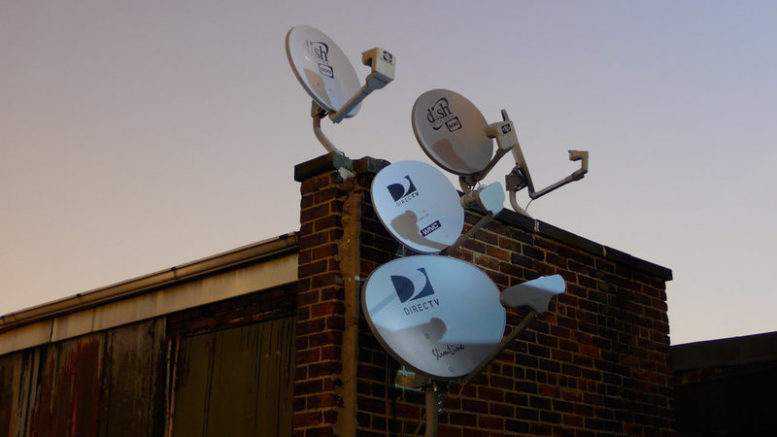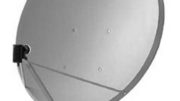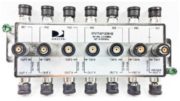Every so often the subject of DIRECTV and DISH merging comes up. It’s one of those rumors that never quite goes away. Certainly, as both companies seem to be in a very mature phase where they’re not growing, it comes up a lot. People think it’s a way to create a more secure and vital company. Is that true? This isn’t the article for that, and I’ve said my peace before.
This article is a little deeper dive into the way DIRECTV and DISH differ in the way you need to wire them. It’s really important to understand, because if one day the two companies do merge, about half the customers (give or take) will need some sort of new equipment. It’s a good idea to understand why.
The DIRECTV method
The core of DIRECTV’s broadcast philosophy can be summed up in three numbers: 99, 101, and 103. They have spent the better part of two decades consolidating all their broadcasts into three satellite locations. In order to do this, they use three different frequency ranges, two of which aren’t used by anyone else in North America. The net result is that every DIRECTV signal that comes from the satellite dish could be identified one of six different ways. (Why six? Because of polarization. Read this article.)
In order to cut down on wiring costs and increase satisfaction, DIRECTV uses its own proprietary scheme to give every receiver and DVR access to each of those six signals. In order to do this, a multiswitch is used that almost acts like a modulator, putting each combination of frequencies and polarities into its own little channel and then having each receiver tune to the channel it wants.
There’s another piece of this puzzle as well. DIRECTV’s home systems are very specialized. Really, there’s a main DVR that does all the receiving, and there are little client boxes that only communicate with the main DVR. In order to accomplish this magic, another whole chunk of frequencies are used just for this type of network communication. So, a single wire can contain 15 different channels to support 15 different recordings on a DVR, as well as networking for up to 8 devices and a connection to the internet. That’s a lot on one wire.
The DISH method
DISH does things differently. Instead of consolidating on one location, they have two completely different fleets of satellites. One serves the west and one serves the east. That should mean that only half the frequencies are needed as DIRECTV. It’s not quite so simple.
First of all there’s some overlap, so that people in the center of the country may get signals from either satellite. The national channels are all on both satellites. On the other hand, DIRECTV has reserved enough frequency space for hundreds (possibly over 1,000) 4K channels that may never come. In the end, it washes out that DISH uses a lot less “spectrum” (the fancy word for the sum of all broadcast frequencies) as DIRECTV.
This makes things easier down on the ground. You can take all the signals from all the satellites you can see (either the west or the east) and “stack” them. Stacking means that you move some of the broadcasts from the frequencies they’re on to other ones, so that they don’t interfere with other broadcasts. Stacking makes things a lot easier because every broadcast you get from the satellite can be on every wire at the same time.
Another way DISH makes things easier is the way it handles network communication. Like DIRECTV, DISH uses a DVR-and-client system. Instead of making it so that network information shares a frequency with satellite information, DISH uses something called a node. The node sends satellite info to the DVR and keeps network information separate. Again, the net result is that it’s easier to have all the information needed on a single wire.
What this all means to you
Here’s the net result. There’s a logical limit of 15 devices that can be on a single line with DIRECTV. The single-wire multiswitch can support 21 devices, but DIRECTV’s internet solution can only support 15. In most cases, the multiswitch itself limits communication to 15 devices (plus one internet connection) so there is no confusion.
DISH, on the other hand, can support 32 devices on one line. The actual number of devices is unlimited, but once you split the signal 32 times it gets too weak and noisy to split it any more.
For both DIRECTV and DISH, you can have a maximum of 8 client boxes that talk to the main DVR box, but this is mostly a function of the amount of network information it takes for each box. It’s like if you and your whole family is trying to use the internet at the same time… it slows down. Only you can’t have a situation where live TV slows down. It either works or it doesn’t. (DIRECTV and DISH don’t allow “buffering” like streaming boxes do.)
The splitter conundrum
There’s one more thing to consider. DIRECTV’s splitters are engineered so that the DVR can be on any port of a splitter and the client boxes can talk from port to port. DISH’s client boxes only talk to the DVR through one path. This makes the splitters between the two different as well.
In the end…
Let’s say you were to try to combine the way DIRECTV does things with the way DISH does things. You’d need to do one of two things. Either you’d have to support two totally incompatible systems, or you’d need to replace the equipment and all the wiring for about half your customers. If a merger does happen, most likely there would be a transition where both systems worked for a while. There would be incentives to switch to new hardware. Eventually there would be a cutoff where old hardware didn’t work. That’s how both companies handled their transition from standard definition to high definition last time. I expect that’s how it would happen again.
It took DIRECTV roughly 17 years — and counting — to make the last transition. I’m counting from the time they first rolled out high definition. They still haven’t finished cutting off standard definition. Would another transition take as long? I don’t know.
This article is brought to you by SolidSignal.com. Shop at Solid Signal for everything you need to live your best digital life. If you have questions, call us at 888-233-7563 or fill out the form below.





